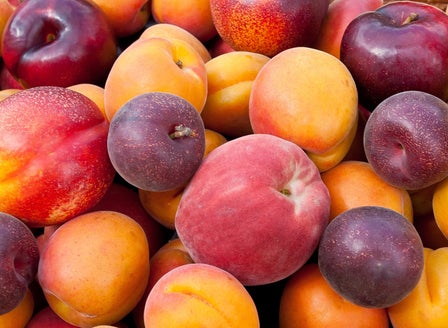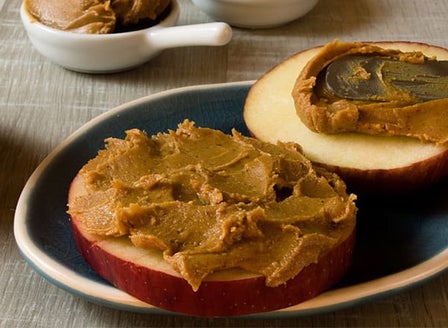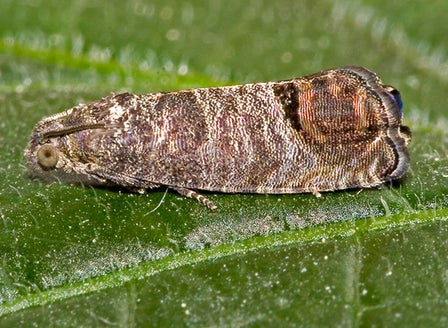What could be better than being able to walk out to your garden and pick your own apple at its freshest and tastiest time. Food tastes better when you've nurtured it and watched it grow to a fully matured plant.
Planting Calendar
Apples should be planted from June through to the end of August. Planting should be done in winter when the trees are fully dormant (when they have completely lost their leaves for the season). This is also the best time of year to buy your apple trees as this is when we have the greatest selection in store.
Harvest In
2 - 4 Years
Apples will be ready to harvest 2 to 4 years after planting. Harvest when fruit comes off easily in your hand with a gentle twist of your wrist. Pips should be black or brown in colour, and rattle gently inside the apple when shaken.
Prepare
Planting should be done in winter and early spring when the trees are fully dormant (when they have completely lost their leaves for the season). This is also the best time of the year to buy your apple trees as this is when we have the greatest selection instore.
Position
Choose a position that gets full sun, or at least 6 hours of direct sunlight daily, protection from wind is also ideal. Plant at least 4 metres apart from other fruit trees, giving them enough space to mature. However, dwarf ‘Ballerina’ and ‘kiwiapple’ varieties can be planted in large pots, or spaced 2 metres apart.
Soil
When planted into the ground Apples like a free draining soil that is rich in organic matter. To improve the organic content in your soil, break up the soil and add Kings Compost and Kings Sheep Pellets then mix together well. When growing in containers, plant into Kings Container mix. This mix contains added water storage crystals and Saturaid, two products that help maintain moisture in the soil.
Pollination
Bees are important for pollination of fruit trees. If you do not have many bees in your garden consider planting blue flowers like borage to draw bees into your garden. In most urban gardens apples will often be pollinated by bees from nearby apple and crabapple trees. Some varieties are self fertile. Planting another variety that is a suitable pollinator will increase the size of the crop. Ask the team at your Local Kings store for the right variety.
Plant
When planting into the ground, gently tap the plant out of its pot. Dig a hole twice the depth and width of the plants root ball. Mix Kings Compost into your existing soil at a 50/50 ratio, add Sheep Pellets and Kings Citrus & Fruit Tree Fertiliser, then mix together well. Back fill the hole with this soil, so that when planted the top of the plant’s roots sit level with the surrounding ground. Insert a hardwood stake next to the plant, being careful not to damage the roots, and tie the tree to it for support with tree-tie. Firm the soil down gently and water in well with Aquaticus Organic Garden Booster. In heavier clay soils, where drainage is likely to be an issue, plant onto a raised mound and sprinkle Gypsum Clay Breaker into the bottom of the hole, this helps slowly condition the soil and will help to break down the clay. When planting into containers, plant in Kings Container mix, as this has water retention crystals in it which will help in keeping the soil moist. Firm the soil down gently and water in well with Aquaticus Organic Garden Booster.
Care
Watering
Watering is essential especially in the first year of planting to allow the roots to get well established. Water slowly allowing the water to sink down into the roots, rather than allowing it to run off the top of the soils surface. Add Saturaid into the soil at planting as this will help channel the water deep down into the root zone. If planted in pots never allow the pot to sit in water.
Feeding
When planted in the ground liquid feed every month with Aquaticus Garden Booster, from Spring through to the end of Autumn, this encourages root growth and increases the microbial activity in the soil. Monthly applications of Kings Sheep Pellets will help with soil conditioning and plant health. In addition, apply Kings Citrus and Fruit Tree Fertiliser in spring and again in autumn to provide the plant all the nutrients it needs. If planted into a containers Feed every 3 months with Kings Slow Release Citrus Food, along with monthly applications of Aquaticus Organic Garden Booster this encourages strong roots and a healthy immune system.
Protecting
Protect from codling moth from September through till February use codling moth traps to monitor the number of moths present. Place the trap half way up the tree. One trap will be sufficient for 4 trees. Remember to replace the pheromone every 6 weeks for best results. If there are only small numbers present the trap should be sufficient to control the problem. If you catch more than 12 moths in a 2 week period, spray trees thoroughly with Success Ultra. Spray no more than 4 times in a season.
Mulching
Mulch around the base of the plants (make sure that the mulch does not come into direct contact with the stem of the plant) with Living Earth More than Mulch. Mulching helps to reduce weeds as well as aiding the soil to retain moisture.
Spraying
Pip fruit need a regular spray program, used for prevention rather than trying to treat the problem once it is active. At a minimum spray with FreeFlo Copper as per instructions on the packet. For more effective results mix with EcoSpread which enhances the performance of the copper.
Pruning
The best time to prune your apple tree is in mid-winter, pruning up to a third of the total growth each year. Always prune your trees on a fine day. • Remove all diseased, damaged and dead wood. • Remove any branches that are crossing or rubbing against each other. • Remove all water shoots (long growth sprouts that grow straight up vigorously). • Remove branches that are growing back into the center of the tree, creating an open vase shape. • Always remove major branches by cutting flush to the trunk. • Smaller cuts should be made on an angle about 15mm above an outward facing bud to promote growth away from the centre of the tree. • Seal cuts above 15 mm in thickness with a Grosafe Organic Prune’N’Paste
General Care
When using sprays, chemicals or fertilisers always read the label and follow the instructions. Apply sprays in the evening to avoid harming beneficial insects.
Beginner Tip
Timing and coverage are critical when applying sprays. They are essential in preventing disease spores from multiplying and re-infecting the tree during flowering and coming into leaf.
Expert Tip
Often a large amount of fruit will set from the blossoms. However, letting these all mature poses a risk of small maturing fruit, high humidity levels causing disease, and branch breakage due to heavy crops. To alleviate this problem, thin (remove) immature fruit by up to a half.
Top Varieties
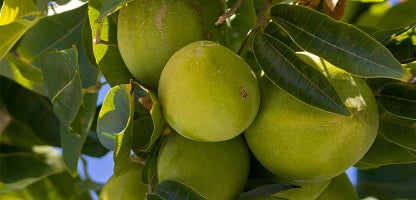
Granny Smith
An old favourite, a large, crisp, green, tart, apple fruiting later in the season during May. If lack of fruit is an issue try planting another suitable variety of apple for added pollination. Suitable pollinators are, Gala, Golden Delicious, Red Delicious, Pink Lady.
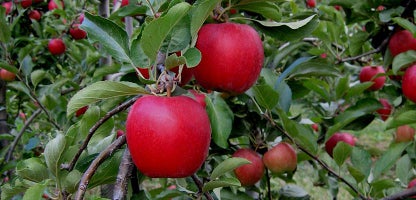
Gala
Needs pollinator. Fruiting early in the season (Feb/March) Gala has red skin, is crisp and has a sweet flavor. Suitable pollinators include: Golden Delicious, Pink Lady, Granny Smith, Red Delicious.
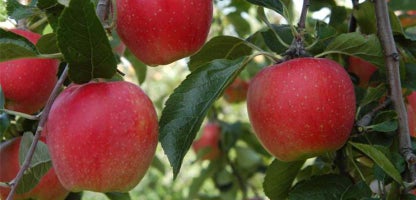
Adore
Self Fertile, Ripening mid season (April) Adore is tasty, crisp and juicy and keeps well. Although self fertile you will get more fruit if you have a pollinator as well. Such as Royal Gala, Golden Delicious, Initial, Granny Smith.
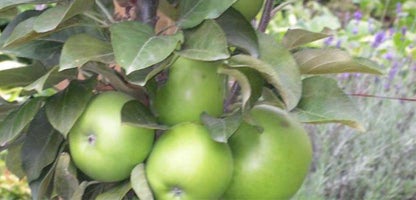
Ballerina Apples.
The most compact apple variety which is well suited to containers or small narrow spaces. Growing in a column shape that gets to 3-4m tall and only 30cm wide.
Frequently Asked Questions
When is the best time to harvest apples?
Apples will be ready to harvest 2 to 4 years after planting. Harvest when fruit comes off easily in your hand with a gentle twist of your wrist. Pips should be black or brown in colour, and rattle gently inside the apple when shaken.
When is the best time to plant apple trees?
The best time to plant apple trees is during the winter months, from June to August. Planting in winter allows the trees to establish roots before the growing season in spring.
How often should I water my apple trees?
Watering is essential especially in the first year of planting to allow the roots to get well established. Water slowly allowing the water to sink down into the roots, rather than allowing it to run off the top of the soils surface. Add Saturaid into the soil at planting as this will help channel the water deep down into the root zone. If planted in pots never allow the pot to sit in water.
Do I need to prune my apple trees?
The best time to prune your apple tree is in mid-winter, pruning up to a third of the total growth each year. Always prune your trees on a fine day. • Remove all diseased, damaged and dead wood. • Remove any branches that are crossing or rubbing against each other. • Remove all water shoots (long growth sprouts that grow straight up vigorously). • Remove branches that are growing back into the center of the tree, creating an open vase shape. • Always remove major branches by cutting flush to the trunk. • Smaller cuts should be made on an angle about 15mm above an outward facing bud to promote growth away from the centre of the tree. • Seal cuts above 15 mm in thickness with a Grosafe Organic Prune’N’Paste
How do I fertilise my apple trees?
If planted into a containers Feed every 3 months with Kings Slow Release Citrus Food, along with monthly applications of Aquaticus Organic Garden Booster this encourages strong roots and a healthy immune system.
